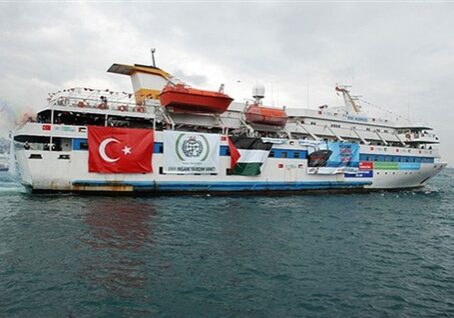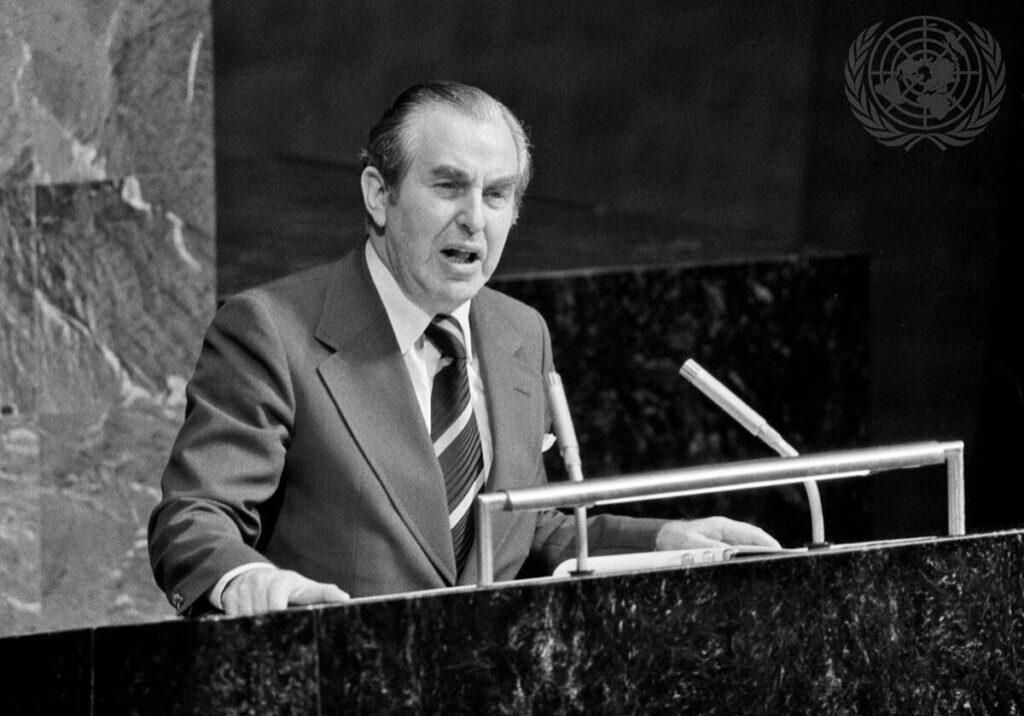Australia/Israel Review
Mounting Tensions
Mar 1, 2007 | Amotz Asa-El
By Amotz Asa-El
It began as a dramatic clash between Israeli sovereignty and Islamist militancy that quickly sparked local riots, regional condemnations and international alarm before being partially defused by an intervention of sorts on behalf of ultra-Orthodox Judaism.
The clash and its pretext were not unprecedented. The Temple Mount, a 12-acre rectangular platform in Old Jerusalem sacred to Judaism as the site of its ancient temples, and to Islam as the place from which Muhammad ascended to heaven, has long been an epicentre of Middle Eastern mayhem. It also has frequently been used as a pretext by those who wish to spark violence.
The delicate balance maintained there since the 1967 Six Day War, whereby thousands of Muslims flock to pray at the trademark gold- and silver-domed mosques on its upper part while thousands of Jews flock to the lower level where they worship by their Roman-era temple’s western retaining wall, has been disturbed repeatedly, and often violently. Now, after the weather-related collapse in 2004 of a ramp that is outside the mosques’ plaza, but leads up to the Mughrabi Gate into the Mount complex, Israeli authorities began construction of a modern bridge which they said would be comfortable, handsome and solid.
Before the actual ramp is built, under Israeli law, the area where the supporting pillars were to be placed had to be examined by archaeologists for any significant artifacts or ruins. And given that the construction was occurring in the Old City of Jerusalem, where there are layers of history everywhere under the ground, this involved digging some significant holes.
However, this is not how Sheikh Raid Salah saw it. The leader of Israel’s most militant Islamist faction, the “northern branch” of the Islamic Movement, insists that the bridge is but a ploy, and the Olmert Government is actually out to undermine the foundations of the al-Aqsa Mosque, Islam’s third holiest site, via the digging. Whether or not he actually believes this theory, which all Western diplomats dismiss as fantasy at best, libel at worst, Salah clearly understood such a “warning” would fall on attentive ears across the Muslim world, and earn him fame as an anti-Western hero alongside Hassan Nasrallah, Mahmoud Ahmadinejad and Osama bin Laden. Salah therefore deliberately clashed with Israeli police who guarded the construction site, yelling at them and even spitting in an officer’s face. His calculation was simple: if the construction workers retreat he will be celebrated, and if they stay put then the wound he has opened will only fester more.
Salah had strong reasons to believe that his claims would be effective. There is a long history of similar claims used to spark violence, and a widespread belief in the Arab world that it is the intention of Israel to destroy the mosques of the Temple Mount and replace them with a Jewish temple. This was the claim that sparked widespread anti-Jewish riots in 1929, while a major series of clashes in 1997 started after a new opening was made to an existing tunnel next to the Mount, and Yasser Arafat declared: “I am ringing the bell of danger to warn against the Jewish plan to build the Temple of Solomon in the place where today stands al-Aqsa Mosque, after removing the mosque.” Similar allegations were spread by Palestinian media to spark the so-called “al-Aqsa” Intifada following the visit of then Israeli opposition leader Ariel Sharon to the Mount complex in 2000.
And predictably, the allegations worked for Salah. His televised confrontation with police in the presence of supporters he brought with him quickly generated applause from Teheran to Cairo, and official reprimands of Israel from Amman to Jakarta. During an official visit to Turkey, Ehud Olmert was handed a formal and public complaint by Prime Minister Recep Tayyip Erdogan, who also said he was “not convinced” by photos Olmert showed of the works at the site. The two agreed that a Turkish mission would probe Israel’s actions at Temple Mount.
Jordan’s condemnation was no less significant since it has enjoyed a special status at Temple Mount, both as the pre-Israeli sovereign and as a post-‘67 renovator of the shrines and sometime arbiter between Israel and Islam. Israel, for its part, in ‘67 handed the administration of the mosques’ area to a council of Muslim clergy, the Waqf. Israel’s founder, David Ben-Gurion, described the situation in June 1967 by saying: “The Western Wall is for the Jews at the moment, and the Temple Mount is for the Muslims at the moment, and that is the reality we have to accept.”
The Waqf, for its part, has been consistently hostile to Israel and systematically blocked all efforts by archaeologists and historians to examine the compound’s rich biblical, Greek, Hasmonean, Roman and early-Christian history.
Part of the arrangement in place since 1967 has been that the Mughrabi Gate into the Mount, adjacent to the Western Wall, as well as the ramp leading up to it remain under Israeli control. It is the only means of access for non-Muslims to visit the Mount, and also provides egress for Israeli police in the event of violence. There have been repeated cases over the years where Muslim worshippers at the mosques have been incited to emerge from their services and throw stones and other projectiles down on Jewish worshippers at the Western Wall below the Temple Mount compound. An attack of this nature occurred on Feb. 9, compelling police to intervene.
The Israeli government, fed by Olmert’s familiarity with the issue as the former mayor of Jerusalem, said it would not change its plans in the face of protests, and that at stake were its sovereignty as well as pubic order. It did, however, make available webcasts of the construction work intended to prove that no undermining of the Mount compound was taking place.
With Olmert compelled to stand his ground and the Islamists eager to torch it, confrontation seemed as inevitable as its aftermath was unpredictable. But then Jerusalem Mayor Uri Lupoliansky introduced a new factor into the equation.
Olmert’s successor as Jerusalem mayor is a strange species in Israel’s political landscape. An ultra-Orthodox father of 12 who earned his fame as founder of a charity that loans medical equipment and deploys some 6,000 volunteers, the bearded, chubby and affable Lupoliansky is not known to eye any job other than his current one. When Olmert was his age, 55, it was common knowledge he was using Jerusalem as a springboard to national leadership. The current mayor is a less ambitious personality. Moreover, having been elected on behalf of a section of Israeli society that is small, disenfranchised, and ambivalent in its attitude toward modernity in general, and the Jewish state in particular, his nationalism is different to that of most Israelis, certainly Olmert’s.
Theologically, Jewish ultra-Orthodoxy has a problem with the Zionist enterprise’s secular roots, and also disagrees with religious Zionism’s view that Israel’s emergence represents the beginning of the redemption Judaism has been awaiting since the Temple’s destruction by Rome in 70 A.D. Consequently, ultra-Orthodox rabbis have traditionally been less concerned about issues of national honour in general, and Israel’s grip on the Temple Mount in particular. In their view, Jews are anyway religiously forbidden to set foot there until the Messiah arrives, and as for the Western Wall area, it should be used for prayers rather than such nationalist statements as the IDF Paratroopers’ swearing-in ceremonies that are traditionally held there.
Though personally Lupoliansky hails from a Zionist household and served in the IDF, this is how his milieu, and the rabbis he follows, view the Temple Mount situation. The mayor’s ultra-Orthodox faith also makes him less reluctant, and better equipped, to dialogue with Muslim clergy.
That, at any rate, is what he chose to do as the crisis escalated, reportedly infuriating Olmert, who had effectively crowned him mayor when he resigned in 2003.
After meeting with members of the Waqf, and using the administrative excuse that the bridge had not been brought to the approval of the National Construction Planning Board, Lupoliansky decided to present the bridge plan to the public so citizens can formally petition the board against it. Until then, he said, construction would be halted. The government, for its part, quickly said the archaeological work at the site in preparation for construction will continue unabated.
Though some analysts believe the mayor’s move was actually masterminded in the government, most are under the impression it caught the government unprepared, and served as a stark reminder that Israel’s capital is both managed and increasingly populated by Jews whose beliefs and priorities are very different from the Jewish majority’s.
This demographic group is increasingly dominant in the city Lupoliansky heads, where most children are now born to ultra-Orthodox parents, and secular young adults are steadily migrating to the more secular coastal plain.
While his efforts on the Temple Mount bridge possibly helped to relieve tension to some degree, the motivation for his intervention was likely as much his beliefs as an ultra-Orthodox Jew as his role as mayor of the capital of Israel.
Tags: Israel






